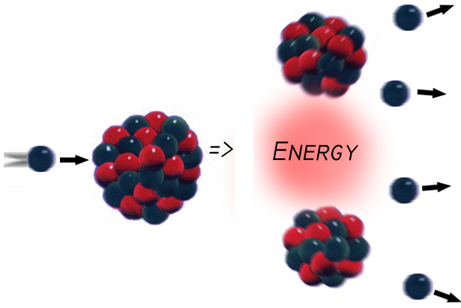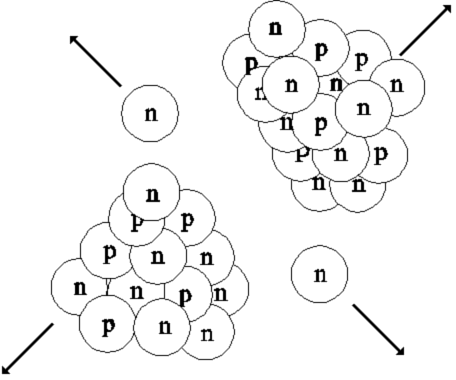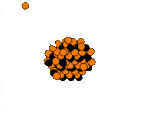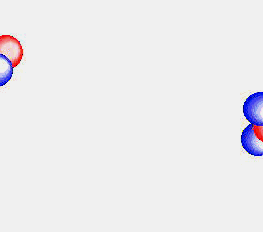The Basic Physics Behind a Nuclear Reactor

The nuclear reactor operates on the principle of nuclear fission, an event that occurs when an atom is struck by a neutron and flies apart.
The figure at right depicts a neutron heading towards a fissile atom (one that is capable of supporting fission). Most often, this is Uranium-235 or Plutonium-239, where the number after the element name indicates the total number of neutrons and protons present in the nucleus of the atom.
When the high-velocity neutron strikes the nucleus, the atom sheds more neutrons and breaks up into several other particles. The motion of all these particles and atoms flying around and colliding creates the heat that is used in power plants to generate electrcity.

Roughly speaking, when the same number of neutrons are created at a given time as are created in a previous generation, a reactor is considered to be 'critical'. If the reaction produces less neutrons than the previous generation, it is 'sub-critical' and, as can be inferred, if the reaction produces more neutrons than the previous generation, it is said to be 'super-critical'. A super-critical reaction is not necessarily bad, as it is the means used by a reactor to increase in power output. If a reactor is 'prompt critical,' however, the operator should be very concerned because the reactor is changing in power very quickly and is very likely moving faster than human reaction time. To prevent a prompt critical state, many standard procedures and regulations have been created and are rigorously enforced.
This also explains why nuclear engineering students cringe when a television show depicts a reactor going critical and then blowing up catastrophically. ( Time travel research © 2005 Cetin BAL - GSM:+90 05366063183 -Turkey/Denizli)
Nuclear Energy
Atoms are the building blocks from which matter is formed. Everything
around us is made up of atoms. Nuclear energy is contained within the center
of the atom in a place known as the
nucleus. Particles within the nucleus are held together by a strong
force. If a large nucleus is split apart
(fission),
generous amounts of energy can be liberated. Small nuclei can also be
combined
(fusion)
with an accompanying release of energy. Using this strong force that holds
the nucleus together to produce energy is essentially what the field of
nuclear power generation is about.
In the fission process certain heavy elements, such as some forms of
Uranium, are split when a
neutron strikes them. When they split, they release energy in the form
of kinetic energy (heat) and
radiation. The process not only produces energy but also additional
neutrons that can be used to fission other Uranium nuclei and start a
chain
reaction.
Time travel research
© 2005 Cetin BAL - GSM:+90 05366063183 -Turkey/Denizli
In fusion, nuclei of light elements are brought together under conditions
of high pressure and temperature, causing them to combine and produce new
elements and energy. (Time travel
research
© 2005 Cetin BAL - GSM:+90 05366063183 -Turkey/Denizli )
Fission

Fission is a nuclear reaction in which an atomic nucleus splits, or
fissions, into fragments, usually two fragments of comparable mass, with the
release of large amounts of energy in the form of heat and radiation. In the
UWNR,
Uranium-235 is the fuel and it is struck by a moving neutron, which
combines with the U-235 to become
U-236. Because of the mass and energy imparted to the nucleus by the
neutron, the nucleus has enough energy to fission and breaks down into two (or
more) smaller nuclei and two or three new neutrons which together have less
mass than the original U-236 nucleus. This missing mass, sometimes known as
the mass defect, is changed into energy.
Zamanda
Yolculuk © 2005 Cetin BAL - GSM:+90 05366063183 -Turkey/Denizli
Fusion

Energy can also be produced by combining light nuclei in a process is called nuclear fusion. As an energy source, fusion has several advantages over fission: the light nuclei are plentiful and easy to obtain, and the end products of fusion are usually light, stable nuclei rather than heavy radioactive ones. There is one considerable disadvantage: before light nuclei can be combined however, their mutual repulsion must be overcome due to the fact that the positively charged protons of the nuclei repulse each other. Because of this problem, fusion reactors are not yet producing electrical power. This is an area of great research interest in the field of nuclear engineering and physics. We at the UWNR do not perform fusion experiments, but if you would like some more information on the fusion projects, click here. (not part of tour) Zamanda Yolculuk © 2005 Cetin BAL - GSM:+90 05366063183 -Turkey/Denizli
Nuclear Energy
There are mines in the southwest United States where giant earth-moving machines remove a crushed gray rock. The rock contains traces of a metal called uranium. The crushed rock must be put through several steps to remove the uranium and turn it into a special kind of fuel. It does not burn like fossil fuels.
The energy in uranium is stored inside the very smallest piece of uranium, the uranium atom. No one has ever seen an atom. Atoms are much too small. But scientists have many other ways of learning about them. We know that there are ninety-two different kinds of atoms on earth. Each kind of atom makes up a different substance called an element. Uranium is the natural element with the heaviest atoms. Hydrogen is the element with the lightest. Oxygen is a light element. Gold and lead are heavy.
In their laboratories, Scientists have made elements that are heavier than naturally occurring elements on earth. All atoms are alike in certain ways. Atoms are not solid balls. Most of the weight of an atom is at its center, called the nucleus. Very tiny, lightweight particles travel at high speeds around the nucleus. These particles are called electrons. Electrons act like planets in orbit. The nucleus is like the sun. There is a lot of space between an atomic nucleus and its electrons. The nucleus of an atom is made of two kinds of particles, protons and neutrons.
Hydrogen, the simplest atom, has a nucleus of only one proton. One kind of uranium has a nucleus of 92 protons and 143 neutrons. When you add 92 and 143, you get 235. So this kind of uranium is called U235. U235 is used as fuel in power plants.
Another kind of uranium has 92 protons and 146 neutrons in its nucleus. It is called U238 and it is not useful as fuel. Most of the uranium that is mined is u238. Only a very tiny amount is U235.
The protons and neutrons in an atomic nucleus are held together with energy called nuclear energy. It takes so much energy to hold the heavy nucleus of the uranium together that eventually the uranium nucleus crumbles, or "decays." As it breaks down, it gives off small amounts of nuclear energy in the form of radiation that is like X-rays.
This kind of energy is called radioactivity. You cannot detect the radioactivity without special instruments. A tiny amount of radioactivity, called background radiation, is always present and is quite harmless. But large amounts of radioactivity can make people sick or even kill them.
How sick you get depends on how much radioactivity you are exposed to and how long you are exposed. Huge amounts in a short period of time can cause death. Exposure to small amounts of radioactivity over a long period of time can cause cancer. So around radioactive substances there is lots of safety equipment and there are many rules for safety.
People who work with nuclear fuel and people who work in nuclear power plants are very will protected against radioactivity. In one year they are exposed to the same amount of radioactivity you might get if you had a few chest X-rays. There are three kinds of radiation. They are alpha particles, beta particles, and gamma rays.
An alpha particle contains two protons and two neutrons. These particles are not very penetrating, and are stopped by a sheet of paper. Beta particles are electrons emitted from atoms. They are a hundred times more penetrating than alpha particles, but a sheet of aluminum three millimeters thick will stop the beta particles. Gamma rays are the third kind of radiation. They are not particles, but invisible rays similar to X-rays. Gamma rays are very penetrating, and need a thick sheet of lead or concrete to stop them.
There are mines in the southwest United States where giant earth-moving machines remove a crushed gray rock. The rock contains traces of a metal called uranium. The crushed rock must be put through several steps to remove the uranium and turn it into a special kind of fuel. It does not burn like fossil fuels.
Every once in a while, decaying uranium nucleus gives off a neutron. This extra neutron is like a bullet. If it strikes another uranium nucleus, it can split the nucleus in half. Splitting the heavy uranium nucleus is called nuclear fission. When nuclear fission takes place, an enormous amount of heat is released, along with lots of radioactivity.
The split nucleus also releases two or three extra neutrons. These extra neutrons can strike other nuclei (meaning more than one nucleus) and split them. This is a chain reaction, in which splitting nuclei cause more nuclei to split, and on and on. When nuclear fission occurs in an atom bomb, all of the heat and radioactivity is released in a split second. But in a power plant, nuclear fission is controlled.
The uranium fuel is in tiny pellets about the size of the tip of your
little finger. The pellets are in rods about twelve feet long. About 200
rods are packed together in a bundle. Bundles are put in the core of the
reactor. Water is pumped around the
 core.
The heat of nuclear fission heats the fuel rods, which in turn heat the
water. It becomes steam, and the steam turns the turbines of the generator.
core.
The heat of nuclear fission heats the fuel rods, which in turn heat the
water. It becomes steam, and the steam turns the turbines of the generator.
The water also contains a substance that catches extra stray neutrons. This removes many of the "bullets," so that the reaction doesn't get out of control and get too hot. There are also lots of control rods sitting next to the core. If there is an emergency, the control rods are pushed into the core, where they absorb the neutrons. This stops the nuclear reaction.
A bundle of nuclear fuel rods last about three years. When it is removed from the core, it is very hot and more radioactive than before. It is stored underwater in special pools. After about eight months it is safe enough to be taken out and packed in cases that will not let the radiation escape.
The fuel pellets can go to a special factory where the remaining useful fuel can be removed and made into new pellets. But there is radioactive waste left over. One problem that has to be solved is what to do with radioactive waste. It must be disposed of safely so that radiation does not leak into the air, water, or ground.
At one time it looked as if nuclear energy would be the main source of energy for the future. Nuclear energy is clean. No pollution comes out of a nuclear power plant. One ton of uranium fuel gives off as much energy as 14,000 tons of coal. And uranium fuel is fairly inexpensive. In addition, there's enough around to last at least 500 years. Scientists have also developed ways to make useful fuel from U238, and the used pellets can be recycled.
But it now looks as if nuclear energy is not the answer to our hopes for future energy. A nuclear power plant is very expensive to build. Many safety features are needed to make sure radiation does not escape into the air. Every step during construction has to be approved by the government. This takes extra time. As time passes, costs go up. Some nuclear power plants have been under construction for fourteen years when they could have taken only six years, and they turned to be much more expensive than anyone expected.
How is the nuclear waste disposed of? It is put into big containers that are buried in the ground. If the people don't have a place to bury the waste it is kept until one is found. Although, they only have one hundred years to find a place before the radiation breaks down the containers. Most people don't want something that is radioactive anywhere near them, so that narrows down burying places. The containers can't be buried over or to close to a fault due to earthquakes and maybe the spread radiation. If water becomes radioactive it is more than useless, it can contaminate other water. If the contaminated water is put into our body, it can kill. That narrows down the places the containers can be buried very little.
Updated: 1/7/03 Hiçbir yazı/ resim izinsiz olarak kullanılamaz!! Telif hakları uyarınca bu bir suçtur..! Tüm hakları Çetin BAL' a aittir. Kaynak gösterilmek şartıyla siteden alıntı yapılabilir.
The Time Machine Project © 2005 Cetin BAL - GSM:+90 05366063183 -Turkiye/Denizli
Ana Sayfa /İndex /Roket bilimi / ![]() E-Mail /CetinBAL /Quantum Teleportation-2
E-Mail /CetinBAL /Quantum Teleportation-2
Time Travel Technology /Ziyaretçi Defteri / Duyuru / UFO Technology